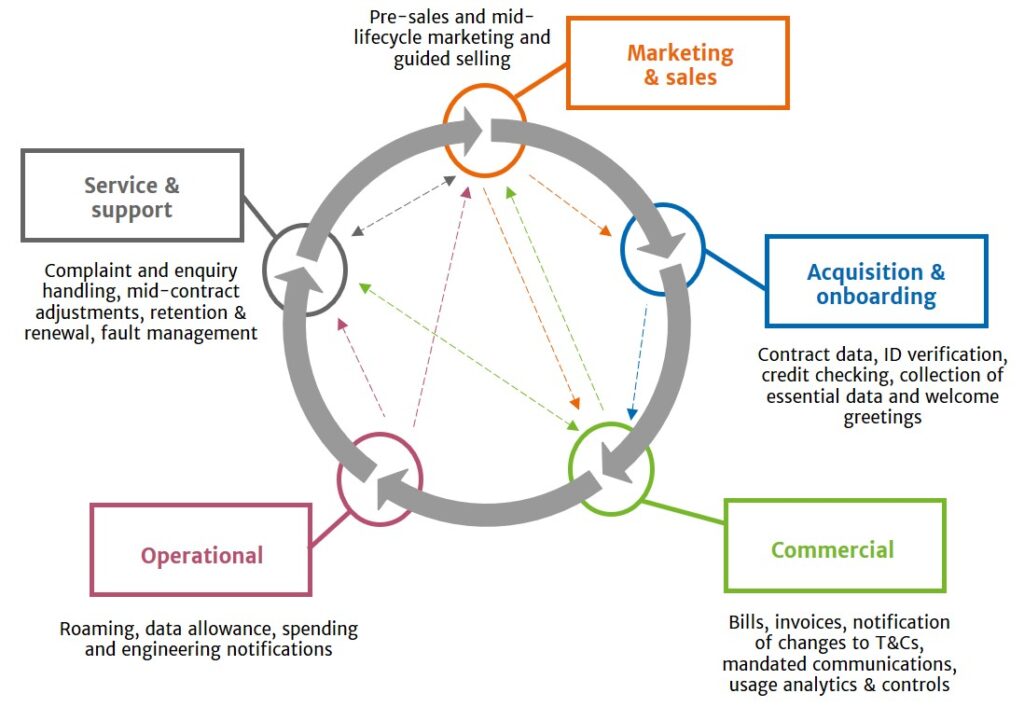LONDON, UK, 9 December 2020, the leading telecoms analyst firm Omnisperience launches new experience concept, arguing that a failure to innovate experience, combined with ineffective communication and engagement strategies, threatens to undermine innovation and 5G commercialisation.
- Billions spent on network investment are at risk due to slow take-up of 5G.
- Customer expectations of 5G are being frustrated by lack of experience innovation.
- Poor communication of new services and price plans threatens to drive up operational costs.
- Unlocking full commercial potential of 5G requires communication innovation.
DSPs are undermining their own 5G investment. Here’s why (and how to fix it).
It’s been 10 years in the making. It’s cost billions to develop and implement. Millions more have been spent on inspirational advertising campaigns depicting an aspirational 5G lifestyle to encourage customers to upgrade.
5G is the panacea we’ve all been waiting for. It’s transformative: changing communications service providers into digital service providers, reshaping the world we live in, and providing a powerful platform for innovation. It’s set to power everything from the Work Anywhere trend, to augmented and virtual reality, the next generation of gaming, connected industrial robots, and self-driving cars. It’s faster, much faster. Very low latency. Exciting. Very exciting.
There’s just one teeny, tiny problem in all of this: no-one is listening.
5G hasn’t grabbed the attention and imagination of consumers in the way that an iPhone launch once did. They’re not getting out of bed before dawn to queue round the corner to sign up. In fact, some are worried by 5G and have begun telling their own scare stories to anyone who’ll listen. Meanwhile, business customers are increasingly frustrated, because 5G isn’t happening fast enough for them and is still more hype than reality.
All customers are asking one very simple question: what’s in it for me?
“The irony of the communications industry is that it’s not very good at communicating with its own customers,” notes Teresa Cottam, Chief Analyst at industry analysts Omnisperience. “And while it’s brilliant at delivering technological innovation, it’s never been very good at innovating the customer experience.” According to Cottam this has led to a widening gap between what customers expect from 5G and what’s actually being delivered.
“The entire 5G proposition is now at risk,” she argues “because the industry is delivering a 5G network but a 2G experience. Without urgent action, 5G will struggle to recover from being a huge disappointment.”
In a new paper launched today, Cottam outlines the long-standing weaknesses in the way mobile operators communicate with their customers. This, she says, has risen to the top of the agenda because unleashing the full potential of 5G is all about effective communication. Cottam comments: “Having spent billions of euros on new networks, and a decade developing and implementing the technology, the mobile industry risks falling at the final hurdle – successful commercialisation.” Making 5G successful and meeting customer expectations requires DSPs to focus on how they communicate 5G to customers, support customers in adopting it and, even more immediately, navigate the complexities of buying it.
‘DCES – Building Value Through Effective Communication & Engagement’ explains why effective communication is a huge commercial issue for digital service providers, impacting on both their top and bottom lines and playing a vital role in building healthy, long-lasting customer relationships. Omnisperience advocates taking a new approach to communication (DCES) which it says increases communication effectiveness, supports communication innovation and unleashes business value by breaking down communication silos and delivering a purposefully designed communication and engagement experience.
**************************ENDS**********************************
WHAT IS DCES?
Digital Communication & Engagement Solutions (DCES) combine all the technologies digital service providers (DSPs) utilise to communicate with their customers, delivering better customer communication and engagement by design. DCES create coherent, resonant and contextual experiences that drive up value and customer loyalty at a lower operational cost.
DCES address the four main sets of risk that result from poor communication & engagement:
- Operational risks – poor communication & engagement increase operational costs by driving up enquiries and complaints from confused customers
- Commercial risks – frustrating sales and onboarding processes will undermine the commercialisation of 5G, making it harder for customers to buy. Poor communication & engagement will see DSPs missing out on vital upsell and cross-sell opportunities.
- Competitive risks – DSPs that improve their digital communications and engagement will be able to retain their customer base while attracting frustrated customers from rival DSPs
- Reputational risks – DSPs that want to be seen as innovative and high-quality brands risk this reputation if they deliver a low-quality experience.
QUOTES ATTRIBUTABLE TO TERESA COTTAM
“What’s the point of a faster network if customers are still waiting in frustratingly long queues to speak to a customer service rep when things go wrong?”
“Anyone can innovate. But successful innovators are also great communicators of innovation.”
“Customer loyalty is created when companies show that their customers matter to them by keeping their promises, being easy to deal with, and communicating effectively.”
“To be successful 5G not only has to deliver network innovation by delivering a fantastic quality of service, whenever and wherever customers need it, but it also has to innovate the customer experience itself.”
“The irony of the communications industry is that it’s not very good at communicating with its own customers. And while it’s brilliant at delivering technological innovation, it’s never been very good at innovating the customer experience.”
“The entire 5G proposition is now at risk because the industry is delivering a 5G network but a 2G experience. Without urgent action, 5G will struggle to recover from being a huge disappointment.”
“Having spent billions of euros on new networks, and a decade developing and implementing the technology, the mobile industry risks falling at the last hurdle – successful commercialisation. Making 5G successful and meeting customer expectations requires DSPs to focus on how they communicate 5G to customers, support customers in adopting it and, even more immediately, navigate the complexities of buying it.”
ABOUT OMNISPERIENCE
Omnisperience is an industry analyst firm that takes a fresh approach to research and advisory projects by helping its customers better understand their market and, as a result, become more profitable. Omnisperience’s experienced analysts focus on digital service providers in the telecoms, media & technology sector (TMT), providing insight that helps them reimagine their businesses and improve their commercial success.
Omnisperience engages and inspires – delivering Value From Experience.
ABOUT TERESA COTTAM
Teresa Cottam leads the research & analysis at Omnisperience. She is a renowned expert on customer experience, employee experience, customer communications & engagement, pricing, packaging & bundling, billing & charging. Teresa is a judge of the GSMA’s Global Mobile Awards (GloMo’s), the UK Cloud Awards, and for Tech Trailblazers. She previously held senior positions at Telesperience, Analysys Mason, Chorleywood Consulting, Informa and Ovum.


Chief Analyst,
Omnisperience
DIAGRAM AND CAPTION
DCES combine all the technologies DSPs utilise to communicate with their customers

MORE INFORMATION
A complimentary copy of ‘DCES – Building Value Through Effective Communication & Engagement’ is available to download here.
CONTACTS
For more information or to request an interview please contact Teresa Cottam